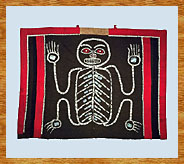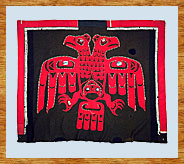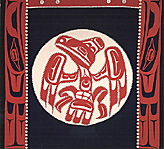
 Clothing Clothing
 Headresses Headresses
 Raven Rattles Raven Rattles
 Copper Shields Copper Shields |
Clothing (Button Blankets)
The button blanket, which came into use after contact, has now become the most popular piece of contemporary feast attire. At first, crest designs decorated with dentalium shells were sewn onto wool blankets acquired from maritime fur traders and later the Hudson's Bay Company. By the middle of the last century, the favoured blanket was made of blue duffle, with the designs appliquéd in red stroud. Squares of abalone shell were sewn to the eyes and joints of the crest figures to reflect bits of light as the wearer danced around a fire. When pearl buttons obtained from fur traders came into use, they proliferated onto the formlines. Today, buttons are sometimes used to fill entire zones of the design elements and even the whole field of the background.


A trade wool blanket decorated with a human figure outlined by dentalium shells, pieces of abalone shell and trade buttons.
Probably acquired at Kasaan village in Alaska circa 1900 by George T. Emmons for the Lord Bossom collection.
CMC VII-B-1525 (S92-4307) |
|

A dark blue trade wool blanket with the design of a double-headed Eagle appliquéd on it in red. Trimmed with dentalium shells, ovoid pieces of abalone shell and a border of mother-of-pearl buttons.
Lord Bossom collection, circa 1900.
CMC VII-B-1521 (S92-4306) |

A modern potlatch can bring forward a hundred or more button blankets from the participants. At a traditional naming ceremony, it is now considered essential to present the recipient with a special blanket decorated with a family crest. A century after the button blanket was first developed, it has become a symbol of social and artistic rebirth among the Haida. One Kaigani Haida artist, Dorothy Grant, has initiated a fashion house specializing in what she labels "Feastwear".

 |
A button blanket by Dorothy Grant, Kaigani Haida, depicting Raven bringing light to the world. This piece was commissioned by Dr. Margaret Hess for the Canadian Museum of Civilization on the occasion of the unveiling of a bronze sculpture on the same theme by Robert Davidson at the Museum of Anthropology in Vancouver, 1986.
CMC VII-B-1832 (S95-26,944) |

|